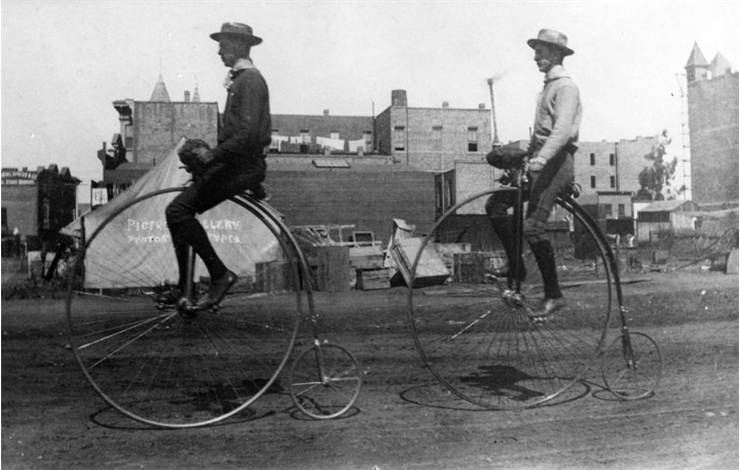Penny-farthing History and Facts
Penny-farthing was a very popular type of bicycle that was most used between the time of the introduction of the French mass produced chain-driven bicycle Boneshaker in 1860s and the English “safety bicycle” in 1880s. During that 20 year period, many inventors tried to revolutionize design and usability of first bicycles, and result of those efforts were penny-farthing bicycles that featured very large front wheel that housed seat and set of pedals, and smaller rear wheel that was there for stabilization. Because of the design of this bike, it had many advantages and disadvantages over the other bicycles or dandy horse bikes of its time. It was more pleasant to drive on rougher surfaces, it was faster than velocipedes, but it was dangerous in the case of fall and mounting and dismounting on them was problematic. Even though they were dangerous for driving, their ability for easier travel over rougher terrain (such as cobbles, stones, ruts, uneven concrete) made it very popular in urban environment where they were driven mostly by the men who had enough money for such an extravagant form of transport. Because of the high appeal of penny-farthing, this bicycle was responsible for the earliest examples of cycling – recreational pastime and sport that soon became very popular around the world after introduction and proliferation of “safety bicycles”.
The origin of Penny-farthing can be located to the Eugène Meyer of Paris who was the first bicycle maker that created high bicycle, new design of tire creation and was first to create classic look of the penny-farthing that became highly popular in England and France. Popularization of the penny-farthing in England can be attributed to the James Starley, who created model named Ariel. He revolutionized many segments of bicycle creation and manufacture, introducing ball bearings, solid rubber tires, hollowed metal steel frames and many more important inventions that soon became standard in entire bicycle industry.
The end of the era of penny-farthing bicycles arrived in 1880s with two significant inventions that made entire concept of one big wheel totally obsolete. First invention arrived from John Kemp Starley (nephew of James Starley) who created Rover Safety Bicycle in 1885 that was much easier for use, less dangerous and faster. Second invention was pneumatic tire of John Dunlop, who created this soft material for use in his son’s tricycle tires in 1888. Introduction of this tire into mass-produced bicycles enabled significantly more stable and able to traverse much rougher environments without shaking the driver much.
After introduction of Rover Safety Bicycle, penny-farthing bicycles receded from the popularity with steady pace. By 1920, all the kinks and problems with safety bicycles were ironed out, and the last official penny-farthing cycling races happened during 1920s. Today, more than 130 years after they were first introduced, penny-farthing bicycles can be seen both as a restorations of the old models and brand new designs that are made by several manufacturers over the world. They can be mostly seen on the streets during various festivals, movies whose story is set in Victorian England or Revolutionary France, circuses and entertainment events.
